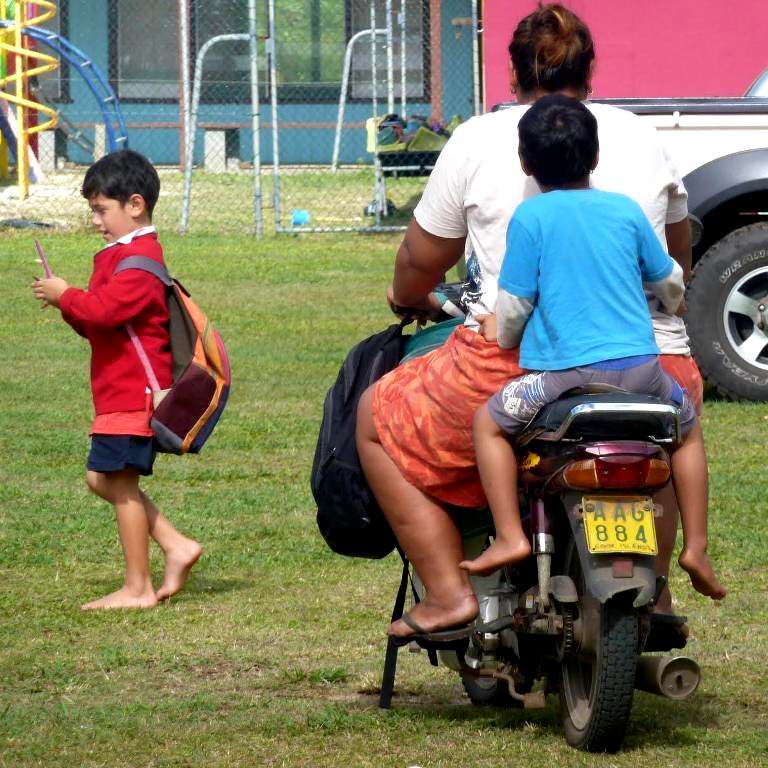
Cook Islands

Figure 1.--These children attend Takitumu Primary School on the east coast of Rarotonga, one of the Cook Islands. They are on their way to school. One of them is walking. It seems that he is playing with an electronic game. The other child is being carried by his mother by moped. The schools don't require a specific uniform.
|
|
The Cook Island archipelago consists of 15 small islands located in the South Pacific northeast of New Zealand about midway between New Xealand and Hawaii. The Cook islanders are a Polyenesian people. Tradition credits Ru from Tupua'i in what is now French Polynesia with leading the first people to the islands. He landed on Aitutaki (about 800 AD). The Islands are of course named after Captain James Cook, who was the first European to site the Islands (1773). Europoean missiinaries converted some of the high chiefs who establishedca unified monarch (1858). The different islands in the group was united as the Kingdom of Rarotonga (1858). Britain at the request of Queen Makea, who was concerned about a French invasion, established a protectorate and created a federal parliament (1888). As New Zealand began to become a more independent Dominion, Britain transfrred authority for the Cook Islands (1901). The Islands were beyond the area conquered by the Japanese in World War II and thus escaped the damage expeienced by other South Pacific islands to the west. The Cook Islands today are a self-governing parliamentary democracy, freely associated with New Zealand. The climate is tropical moderated by trade winds. There is a dry season (April to November) and a more humid season (December to March). The terraine varies. The northern islands are low coral atolls. The southern islands are more hilly, volcanic in origin. There are no important natural resources. We have a Cook Island school page. We also have a page on Scouting, the only known youth group.
Geography
The Cook Island archipelago consists of 15 small islands located in the South Pacific northeast of New Zealand about midway between New Xealand and Hawaii. The terraine varies. The northern islands are low coral atolls. The southern islands are more hilly, volcanic in origin. There are no important natural resources.
Climate
The climate is tropical moderated by trade winds. There is a dry season (April to November) and a more humid season (December to March).
Ethnicity
The Cook islanders are a Polyenesian people.
History
Tradition credits Ru from Tupua'i in what is now French Polynesia with leading the first people to the islands. He landed on Aitutaki (about 800 AD). The Islands are of course named after Captain James Cook, who was the first European to site the Islands (1773). Europoean missiinaries converted some of the high chiefs who establishedca unified monarch (1858). The different islands in the group was united as the Kingdom of Rarotonga (1858). Britain at the request of Queen Makea, who was concerned about a French invasion, established a protectorate and created a federal parliament (1888). As New Zealand began to become a more independent Dominion, Britain transfrred authority for the Cook Islands (1901). The Islands were beyond the area conquered by the Japanese in World War II and thus escaped the damage expeienced by other South Pacific islands to the west. The Cook Islands today are a self-governing parliamentary democracy, freely associated with New Zealand.
Economics
Garments
Boys seem to have adopted mostly Western clothing. Most boys wear casual clothing, often a T-shirt and short pants. Boys often go barefoot. New Zealand styles are a major inflkuence.
We have some information about boys' activities on the Cook Island. School is a fairly recent innovation. We have a Cook Island school page. Religion is also important. Most Cook Islanders are Christians. Sports are mow popular. Again New Zealnd are important is a major influence. As a result, rugby is the most popular sport, almost to the exclusion of other sports. We also have a page on Scouting, the only known youth group. These all seem to be imported activities. Surely there mit be some popular traditional activities. Hopefully any Cook Island visitors can provide some information here.
HBC

Navigate the Boys' Historical Clothing Web Site:
[Return to the Main Oceania page]
[Return to the Main countries page]
[Introduction]
[Activities]
[Biographies]
[Chronology]
[Cloth and textiles]
[Clothing styles]
[Countries]
[Topics]
[Bibliographies]
[Contributions]
[FAQs]
[Glossaries]
[Images]
[Links]
[Registration]
[Tools]
[Boys' Clothing Home]
Created: 5:51 PM 2/28/2012
Last updated: 9:18 PM 3/2/2012



